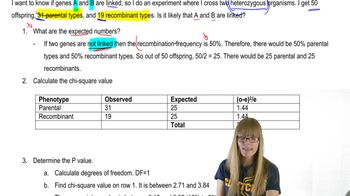Which of the following is an example of sex-limited inheritance?
Table of contents
- 1. Introduction to Genetics51m
- 2. Mendel's Laws of Inheritance3h 37m
- 3. Extensions to Mendelian Inheritance2h 41m
- 4. Genetic Mapping and Linkage2h 28m
- 5. Genetics of Bacteria and Viruses1h 21m
- 6. Chromosomal Variation1h 48m
- 7. DNA and Chromosome Structure56m
- 8. DNA Replication1h 10m
- 9. Mitosis and Meiosis1h 34m
- 10. Transcription1h 0m
- 11. Translation58m
- 12. Gene Regulation in Prokaryotes1h 19m
- 13. Gene Regulation in Eukaryotes44m
- 14. Genetic Control of Development44m
- 15. Genomes and Genomics1h 50m
- 16. Transposable Elements47m
- 17. Mutation, Repair, and Recombination1h 6m
- 18. Molecular Genetic Tools19m
- 19. Cancer Genetics29m
- 20. Quantitative Genetics1h 26m
- 21. Population Genetics50m
- 22. Evolutionary Genetics29m
2. Mendel's Laws of Inheritance
Sex-Linked Genes
Problem 6d
Textbook Question
In Drosophila, the map positions of genes are given in map units numbering from one end of a chromosome to the other. The X chromosome of Drosophila is 66 m.u. long. The X-linked gene for body color—with two alleles, y⁺ for gray body and y for yellow body—resides at one end of the chromosome at map position 0.0. A nearby locus for eye color, with alleles w⁺ for red eye and w for white eye, is located at map position 1.5. A third X-linked gene, controlling bristle form, with f⁺ for normal bristles and f for forked bristles, is located at map position 56.7. At each locus the wild-type allele is dominant over the mutant allele.
Explain how each of the predicted progeny classes is produced.
 Verified step by step guidance
Verified step by step guidance1
Understand the genetic setup: The problem involves three X-linked genes in Drosophila, each with a wild-type (dominant) and mutant (recessive) allele. The genes are located at specific map positions on the X chromosome: y⁺/y (body color) at 0.0 m.u., w⁺/w (eye color) at 1.5 m.u., and f⁺/f (bristle form) at 56.7 m.u.
Recognize the concept of recombination: The map positions indicate the likelihood of crossing over between genes during meiosis. The farther apart two genes are, the higher the probability of recombination between them. For example, y and w are close (1.5 m.u. apart), so recombination between them is rare, while y and f are far apart (56.7 m.u.), making recombination more likely.
Determine the parental and recombinant gametes: Parental gametes retain the original combinations of alleles (e.g., y⁺w⁺f⁺ or ywf), while recombinant gametes result from crossing over (e.g., y⁺wf or yw⁺f⁺). The frequency of each gamete type depends on the recombination rates derived from the map distances.
Predict progeny classes: The progeny classes are determined by the combinations of gametes from the parents. For example, if a heterozygous female (y⁺w⁺f/ywf) is crossed with a hemizygous male (ywf), the offspring will inherit one X chromosome from the mother and one from the father. The specific combinations of alleles in the progeny depend on whether the maternal gamete is parental or recombinant.
Explain the production of each progeny class: Parental progeny classes (e.g., y⁺w⁺f and ywf) result from gametes without crossing over, while recombinant progeny classes (e.g., y⁺wf or yw⁺f⁺) result from crossing over events. The relative frequencies of these classes reflect the map distances between the genes, with closer genes producing fewer recombinants and farther-apart genes producing more recombinants.
 Verified video answer for a similar problem:
Verified video answer for a similar problem:This video solution was recommended by our tutors as helpful for the problem above
Video duration:
1mPlay a video:
Was this helpful?
Key Concepts
Here are the essential concepts you must grasp in order to answer the question correctly.
Genetic Linkage
Genetic linkage refers to the tendency of genes located close to each other on a chromosome to be inherited together during meiosis. This is due to their physical proximity, which reduces the likelihood of recombination occurring between them. In the context of Drosophila, the proximity of the body color gene to the eye color gene suggests that they may be inherited together more frequently than genes that are farther apart, such as the bristle form gene.
Recommended video:
Guided course

Chi Square and Linkage
Map Units and Recombination Frequency
Map units, or centimorgans (cM), are a measure of genetic distance based on the frequency of recombination between loci during meiosis. One map unit corresponds to a 1% chance of recombination occurring between two genes. In the given Drosophila example, the distances between the body color and eye color genes (1.5 m.u.) and the bristle form gene (56.7 m.u.) indicate how likely these genes are to be separated during gamete formation, influencing the expected progeny classes.
Recommended video:
Guided course

Mapping Genes
Dominance and Allelic Interactions
Dominance describes the relationship between alleles of a gene, where the presence of a dominant allele masks the expression of a recessive allele. In the Drosophila example, the wild-type alleles (y⁺, w⁺, f⁺) are dominant over their respective mutant alleles (y, w, f). This dominance affects the phenotypic ratios of the progeny, as the combination of alleles inherited from the parents will determine the observable traits in the offspring.
Recommended video:
Guided course

Variations on Dominance
Related Videos
Related Practice
Multiple Choice
909
views
2
rank


